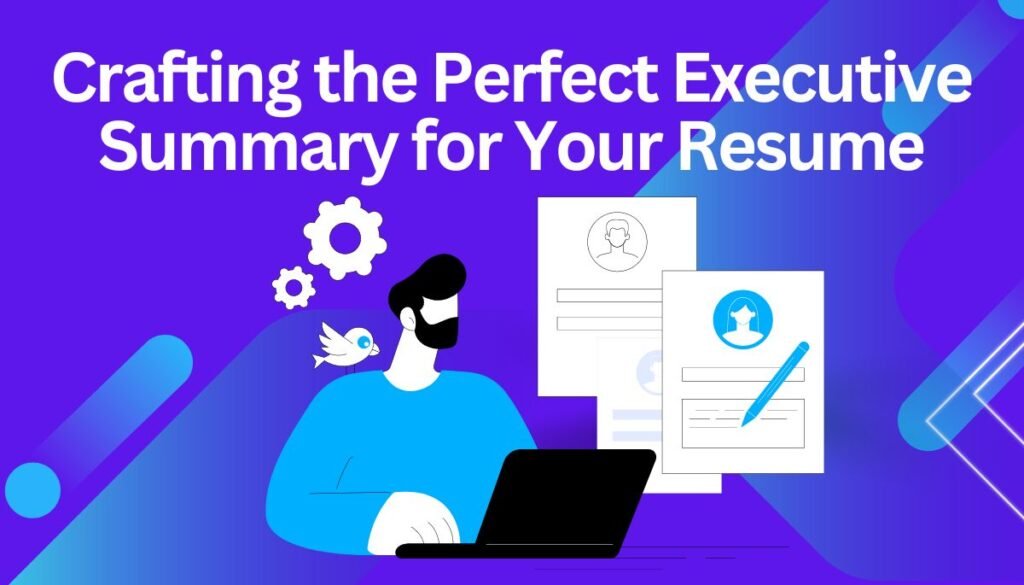
Crafting the Perfect Executive Summary for Your Resume
Have you ever wondered why some people seem to effortlessly land job interviews, while others struggle? The key often lies in the first few lines of their resume – the executive summary. This golden nugget of your resume is your chance to shine, to show off your skills, and to make a memorable first impression.
The Power of the Executive Summary
In today’s hyper-competitive job market, making a lasting impression in a matter of seconds is crucial. That’s where the executive summary comes in. Think of it as your resume’s personal elevator pitch – a powerful paragraph designed to grab the attention of hiring managers and recruiters instantly.
An executive summary in resume writing is essentially a more focused and impactful replacement for the traditional objective statement.
Differences between an Executive Summary and a Resume Objective
| Feature | Resume Objective | Executive Summary |
| Focus | What the candidate wants from the position | What the candidate offers to the employer |
| Specificity | Generic, often very similar across resumes | Highlights distinct skills and achievements tailored to the job |
| Impact | Can be easily forgettable | Grabs attention, showcases the candidate’s value, and leaves the reader wanting to know more |
Why Every Resume Needs an Executive Summary
- Brevity in a Time-Starved World: Recruiters typically spend a mere seconds scanning a resume. An executive summary distills your core qualifications into a snapshot, providing the most critical information at a glance.
- Immediate Value Proposition: While your job history explains your past, the executive summary highlights your present and future potential for the specific role. It primes the reader to look for evidence of your claims throughout the rest of your resume.
- Targeted Marketing: A strong executive summary is tailored to each job application. This targeted messaging demonstrates that you’ve done your research, understand the company’s needs, and are genuinely invested in the role.
The Building Blocks of a Compelling Executive Summary
A great executive summary isn’t a repetition of your resume, but a carefully curated distillation of your strengths specifically aligned with the job. Here’s how to build it:
- Mining Job Descriptions for Gold: Meticulously examine the job description. Highlight keywords, required skills, desired qualifications, and any pain points the company might be facing. These keywords become the skeleton of your executive summary.
- Match Your Arsenal to Their Needs: Analyze your past experience. Choose 2-3 of your most relevant core skills and achievements that align with the job keywords. This targeted matching highlights your immediate suitability.
- Don’t Be Modest: Quantify Your Awesomeness: Numbers speak louder than words. If possible, quantify your achievements. Instead of “Increased sales”, write “Increased sales by 15% year-over-year”. Be specific and provide evidence of your impact.
- Crafting the Narrative: Strive for 3-5 concise, powerful sentences. Open with a punchy line that summarizes your professional experience and primary skillset. Then, follow with 2-3 sentences showcasing relevant skills and quantified achievements.
- Location: Place your executive summary right at the top of your resume, directly under your name and contact information. This prime real estate guarantees visibility.
Executive Summary Examples
Entry-Level Candidate Example:
“Recent marketing graduate with proven talent for social media engagement. Increased Instagram followers by 30% for a local business internship. Expertise in content creation, analytics, and emerging platform trends.”
Career Changer Example
“Solutions-oriented project manager with 8+ years of experience in client-facing roles. Excel at streamlining processes, improving communication, and consistently delivering projects on time. Seeking to leverage transferable skills in a fast-paced tech environment.”
Experienced Professional Example
“Senior sales executive with a 10-year track record of exceeding sales quotas. Expertise in consultative selling, strategic partnership development, and key account management. Proven ability to generate new business and nurture long-term client relationships.”
Supercharging Your Executive Summary
The Power of Action Verbs: Start sentences with strong action verbs (e.g., Managed, Developed, Increased, Led) to convey initiative and results.
Proofreading is Paramount: Even the smallest error in your executive summary can undermine your credibility. Proofread meticulously, and have a trusted friend or colleague review it for clarity and impact.
Adapt and Conquer: Never use the same executive summary for multiple applications. Tweak it slightly for each role, focusing on the skills and achievements most pertinent to that specific position.
Conclusion
Remember, your executive summary is your chance to engage, impress, and persuade. It’s the hook that draws the reader into the story of your career. With the right approach, your executive summary can transform your resume from just another application to the top of the interview pile.
FAQs on Crafting an Executive Summary
Q: How long should my executive summary be?
A: Aim for 3-5 sentences. It’s about quality, not quantity.
Q: Should I include specific numbers in my achievements?
A: Absolutely. Quantifying your achievements makes them more impactful.
Q: Can I use the same summary for every application?
A: It’s essential to tailor your summary to each job. Customization shows you’ve done your homework and are genuinely interested in the position.
Q: How important is it to use keywords from the job description?
A: Very. It helps your resume pass through Applicant Tracking Systems (ATS) and shows that you’re a good match for the role.
Q: Can my executive summary make or break my resume?
A: Yes, it can. A compelling summary can significantly increase your chances of landing an interview, while a weak one might result in your resume being overlooked.
Crafting the perfect executive summary is an art, but it’s one you can master with practice, insight, and a bit of strategic thinking. So go ahead, make your mark, and let your resume open doors to new opportunities.